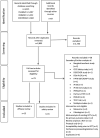Oral pre-exposure prophylaxis (PrEP) to prevent HIV: a systematic review and meta-analysis of clinical effectiveness, safety, adherence and risk compensation in all populations
- PMID: 35545381
- PMCID: PMC9096492
- DOI: 10.1136/bmjopen-2020-048478
Oral pre-exposure prophylaxis (PrEP) to prevent HIV: a systematic review and meta-analysis of clinical effectiveness, safety, adherence and risk compensation in all populations
Abstract
Objective: To conduct a systematic review and meta-analysis of randomised controlled trials (RCTs) of the effectiveness and safety of oral pre-exposure prophylaxis (PrEP) to prevent HIV.
Methods: Databases (PubMed, Embase and the Cochrane Register of Controlled Trials) were searched up to 5 July 2020. Search terms for 'HIV' were combined with terms for 'PrEP' or 'tenofovir/emtricitabine'. RCTs were included that compared oral tenofovir-containing PrEP to placebo, no treatment or alternative medication/dosing schedule. The primary outcome was the rate ratio (RR) of HIV infection using a modified intention-to-treat analysis. Secondary outcomes included safety, adherence and risk compensation. All analyses were stratified a priori by population: men who have sex with men (MSM), serodiscordant couples, heterosexuals and people who inject drugs (PWIDs). The quality of individual studies was assessed using the Cochrane risk-of-bias tool, and the certainty of evidence was assessed using GRADE.
Results: Of 2803 unique records, 15 RCTs met our inclusion criteria. Over 25 000 participants were included, encompassing 38 289 person-years of follow-up data. PrEP was found to be effective in MSM (RR 0.25, 95% CI 0.1 to 0.61; absolute rate difference (RD) -0.03, 95% CI -0.01 to -0.05), serodiscordant couples (RR 0.25, 95% CI 0.14 to 0.46; RD -0.01, 95% CI -0.01 to -0.02) and PWID (RR 0.51, 95% CI 0.29 to 0.92; RD -0.00, 95% CI -0.00 to -0.01), but not in heterosexuals (RR 0.77, 95% CI 0.46 to 1.29). Efficacy was strongly associated with adherence (p<0.01). PrEP was found to be safe, but unrecognised HIV at enrolment increased the risk of viral drug resistance mutations. Evidence for behaviour change or an increase in sexually transmitted infections was not found.
Conclusions: PrEP is safe and effective in MSM, serodiscordant couples and PWIDs. Additional research is needed prior to recommending PrEP in heterosexuals. No RCTs reported effectiveness or safety data for other high-risk groups, such as transgender women and sex workers.
Prospero registration number: CRD42017065937.
Keywords: HIV & AIDS; epidemiology; infectious diseases; public health.
© Author(s) (or their employer(s)) 2022. Re-use permitted under CC BY-NC. No commercial re-use. See rights and permissions. Published by BMJ.
Conflict of interest statement
Competing interests: None declared.
Figures




References
-
- UNAIDS . Global HIV & AIDS statistics — 2020 fact sheet, 2020. Available: https://www.unaids.org/en/resources/fact-sheet [Accessed 11 Sep 2021].
-
- WHO . Consolidated guidelines on HIV prevention, diagnosis, treatment and care for key populations, 2014. Available: https://www.who.int/hiv/pub/guidelines/keypopulations/en/ [Accessed 22 Jul 2019]. - PubMed
-
- WHO . WHO expands recommendation on oral preexposure prophylaxis of HIV infection (PreP), 2015. Available: https://apps.who.int/iris/bitstream/handle/10665/197906/WHO_HIV_2015.48_... [Accessed 22 Jul 2019].
Publication types
MeSH terms
Substances
LinkOut - more resources
Full Text Sources
Medical
Miscellaneous
